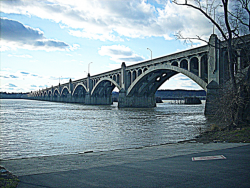
The total length of the Columbia-Wrightsville Bridge is 7,374 feet. Its construction required 100,000 cubic yards of concrete and 8 million pounds of steel reinforcing rods.
Consisting of 28 arches, each 185 feet long, the Columbia-Wrightsville Bridge carrying automobile traffic across the Susquehanna River in southeast Pennsylvania is believed to be the longest concrete-arch bridge in the world. The bridge's location is also historically significant. The longest covered wooden bridge in the world - 5,690 feet long - was built there in 1814, only to be destroyed by ice and floods almost 20 years later. Its replacement - 70 feet shorter but considerably wider - was burned 30 years later by Union troops as a tactical measure during the Civil War.
A third bridge - 5,390 feet long - remained in place nearly another 30 years until its destruction by a hurricane in 1896. The fourth Columbia-Wrightsville Bridge, of steel-truss construction, was erected in only 21 days and carried rail and highway traffic on the same deck. The trains ultimately proved to be a significant bottleneck to traffic on the transcontinental Lincoln Highway, completed in 1925. The present Columbia-Wrightsville bridge, dedicated solely to highway traffic, was built alongside the fourth bridge.
Facts
- The total length of the Columbia-Wrightsville Bridge is 7,374 feet. Its construction required 100,000 cubic yards of concrete and 8 million pounds of steel reinforcing rods.
- Each span of the present Columbia-Wrightsville Bridge consists of three separate concrete ribs connected at five points by horizontal concrete struts.
- In nominating the present Columbia-Wrightsville Bridge as an engineering landmark, the Pennsylvania section of the American Society of Civil Engineers noted that it is "a splendid example of the graceful multiple-span, reinforced-concrete arched form popular in early 20th-century highway bridges in the United States."
- The Lincoln Highway, also known as U.S. Highway 30, was the nation's first transcontinental highway, connecting a series of local highways and stretching from New York City to San Francisco. The opening in 1940 of the cross-state Pennsylvania Turnpike, a part of Interstate 76, subsequently provided faster passage.
- The fourth Columbia-Wrightsville bridge carried passenger trains until 1954 and freight traffic until 1958. It was not dismantled until 1964. Remnants of the piers that supported it remain visible today.
Resources
- Glenn Banner, Flames Across the Susquehanna, Columbia Historical Preservation Society.


